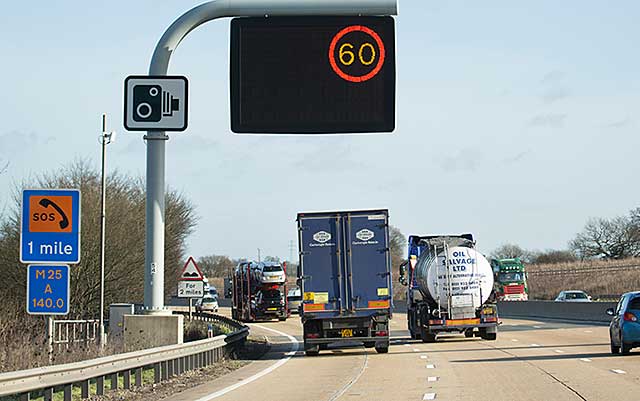19 October 2017
When breaking down on a Smart motorway without a hard shoulder, a third (32%*) of drivers are only prepared to drive up to a quarter of a mile in order to reach an Emergency Refuge Area (ERA) before stopping in a live lane, according to a study by the AA.
The AA-Populus Driver Poll of more than 17,500 members, found that a further quarter (23%) of drivers would only be willing to drive for up to half a mile in search of a refuge area before giving up and stopping in a live lane.

On 30 June 2016, the Transport Select Committee recommended that the Government stop the roll out of all-lane-running schemes and revert to the design used for the M42 trial** for all future schemes. Under this system the hard shoulder is used only at peak times and ERAs are spaced 800 meters apart.
Responding to the Transport Select Committee on 29 September 2016, the Government said: “Highways England has committed to review ERA spacing as part of a broader approach to reduce the frequency and risk associated with live lane stops.”***
More than 12 months on Highways England is yet to publish their findings on the spacing review. The current guidelines say that ERAs, or an exit, should be spaced no more than 2.5 km apart.
Potentially dangerous
Edmund King, AA president says: “Drivers are still nervous about using all lane running schemes under their current design. With more than half of drivers only willing to drive up to half a mile before stopping in a live lane shows how potentially dangerous the current schemes might be.
“Before and since the introduction of all lane running schemes we, and the emergency services, have continuously called for more emergency refuge areas to be provided.
Before and since the introduction of all-lane-running schemes we, and the emergency services, have continuously called for more emergency refuge areas to be provided
“Over a year ago, Highways England agreed to review the spacing of refuge areas, and we look forward to seeing the findings.”
King continues: “We contributed to the review of emergency refuge areas, and are pleased to see that some positive changes have already been made. The introduction of more and clearer signage and painted refuges are a step in the right direction.
“Increasing the number of refuge areas would help ease drivers' concerns, and provide confidence of getting to safety should the worst happen.
“We want to see capacity increased on the motorway network, but safety should not be compromised. We should aim to create the safest roads that we can.”
* Populus received 17,575 responses from AA members to its online poll between the 17th and 24th January 2017. Populus is a member of the British Polling Council and abides by its rules.
** Select Committee report, recommendations 5, 12, 15 and 18
***Government response, recommendation 5, final paragraph, page 10
